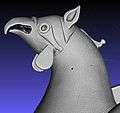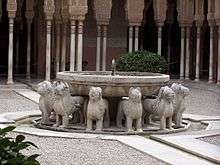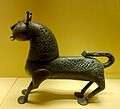Pisa Griffin
The Pisa Griffin is a large bronze sculpture of a griffin, a mythical beast, which has been in Pisa in Italy since the Middle Ages, though it is of Islamic origin. It is the largest medieval Islamic metal sculpture known, at over three feet tall (42.5 inches, or 1.07 m.), and was probably created in the 11th century in Al-Andalus (Islamic Spain).[1] It has been described as the "most famous as well as the most beautiful and monumental example" of a tradition of zoomorphic bronzes in Islamic art.[2] It is now in the Museo dell'Opera del Duomo (Cathedral Museum), Pisa.
Description
The griffin has the head of an eagle; but it has ears like those of a horse as well as the wattles of a rooster, wings, and the body of a lion, or other mammal(s), with toes. Its dimensions are: height 107 cm; length 87 cm; width 43 cm. It is made of cast bronze (i.e. copper alloy) with the wings cast separately and held in place by rivets; it is largely hollow inside. There is an engraved decoration, including an Arabic inscription in Kufic letters round the beast's chest and flanks saying: "Perfect benediction, complete wellbeing, perfect joy, eternal peace and perfect health, and happiness and good fortune (?) for the owner".[3] The wings are decorated with stylized feathers, the chest with overlapping semi-circular scales, and the back with a pattern of plain circles enclosed in two rings, on a textured background. At the top of each leg there is a more elaborate, inverted teardrop-shaped zone or cartouche, where arabesques surround an animal, lions on each front leg and birds, presumably eagles, on each rear one.[4]
There are three openings to the interior of the statue, which contains fittings given various interpretations, described below. There are openings at the mouth, rear – perhaps for a missing tail – and a larger one under the belly. Inside is "a globular “cup” made of bronze, open towards the belly and soldered on the back with a fine piece of the same metal".[5]
- In the cathedral's chapter house in 2014
Original use and context
_01.jpg)
The griffin is the largest of a group of surviving Islamic bronze animals, most of which are much smaller and functioned as aquamaniles, incense-burners and the like, and whose origin goes back to pre-Islamic Sassanian vessels.[6] A much smaller group of middle-sized works contains several that were clearly fountainheads, probably originally arranged in circular groups facing outwards, in the manner of the famous stone lions still in place at the Alhambra in Granada.[7] Among the group of non-portable early Islamic bronze animals, two have been sold in recent years, both clearly made as fountainheads: a lion, perhaps from Sicily and rather later in date, was sold for £1,546,650 at Sotheby's in 2002,[8] and a 10th-century hind (female deer) from Cordoba, which realized £3,631,500 in 1997 at Christie's.[9] This latter is said to be a companion of the "Cordoba Stag", the best known of the group after the Pisa Griffin, which is now 61.6 cm high, though lacking the antlers it is presumed to have originally had, and dates to ca. 950–1000. It is in the Museo Arqueológico Provincial de Cordoba, and was found in the ruins of the large palace-city Madinat Al-Zahra outside Cordoba.[10] Another, not matching, hind fountainhead from Madinat Al-Zahra is in the National Archaeological Museum of Spain in Madrid (right); the 16th century historian al-Maqqari mentions "...marble basins with elaborate spouts at the palace of Madinat al-Zahra'. One of these was surrounded by twelve gold animal sculptures which spewed water from their mouths".[11] Smaller pieces are the "Kassel Lion" signed by Abd Allah Mattial from the 10th or 11th century (Kassel Museum),[12] and the "Monzon lion" in the Louvre.[13]
It has been suggested that the griffin too might have been placed in a fountain, with water spouting from its mouth, but a more recent theory, based on the remains of its internal features, is that both it and a smaller lion in the Metropolitan Museum of Art in New York, were in fact designed to emit noises from their mouth, as a kind of mechanical toy of a sort known to have been enjoyed in Islamic courts.[14]
Locating the area where the griffin was made has been the subject of considerable dedate, with Al-Andalus, Egypt, Sicily, North Africa and other places suggested at various points. Debate focuses on a group of bronzes of one sort or another that are often thought to have been made in the same area. Al-Andalus remains the most popular choice, but South Italy or Sicily are possible, though Egypt seems to have largely fallen out of contention.[15]
Robert Hillenbrand suggests that the fantastic nature of the griffin and other statues of animals was influenced by a belief that such mythical beasts were less likely to be regarded as idolatrous than lifelike animal forms.[16] All representations of animals were against strict interpretations of Islam, and three-dimensional ones, especially when large, were especially likely to be accused of skirting idolatry, and are rare in Islamic art. An aquamanile in the Hermitage Museum of a cow and calf attacked by a lion has later had the throats of the animals cut with a sharp groove, apparently to make it clear that they are dead.[17] Oleg Grabar suggests that the engraved decoration may be "translations into cheaper bronze" of inlays and enamelling found on gold and silver Byzantine objects.[18] The circular patterns on the griffin's back and several of the other works mentioned above derive from textile designs.[19]
 Detail of the Kufic inscription on the Pisa Griffin
Detail of the Kufic inscription on the Pisa Griffin A rendering of the 3D scanned model showing the details of the carving on the head.
A rendering of the 3D scanned model showing the details of the carving on the head.- The Monzon Lion, 12th-13th century, now in the Louvre
 The Lion Fountain in the Alhambra, 14th century
The Lion Fountain in the Alhambra, 14th century Persian incense-burner, 11th–12th century
Persian incense-burner, 11th–12th century_01.jpg) Persian aquamanile with cartouche above leg, c. 1100, imported to Europe
Persian aquamanile with cartouche above leg, c. 1100, imported to Europe
History
The griffin is generally agreed to have arrived in Pisa at some point during the late 11th or early 12th century, and may have been a spoil of one of the many successful "wars" or raids conducted by the Republic of Pisa against Islamic states at this period, when the small city was at the height of its power as a maritime republic. The successful attack in 1087 on Mahdia in modern Tunisia, capital of the local Zirid dynasty is one candidate.[21] The griffin was placed on a platform on top of a column rising from the gable above the apse at the east end of Pisa Cathedral, probably as part of the original construction, which was begun in 1064. This was a very prominent position, but one that meant that it could not be seen close up, and its Islamic origins were forgotten over the centuries.[22] According to later local legends it was variously said to be Roman, a local medieval creation, a spoil of war from 1115, or miraculously found when the foundations of the cathedral were being excavated.[23] Large-scale European bronze casting at this period specialized in fonts and pairs of doors, of which there is a fine Romanesque pair with reliefs in the same museum.
In 1828 the griffin was removed and placed in the Cathedral Museum, with a replica later placed in the original position. Once seen closely, the Kufic inscription made its Islamic origins plain, although Murray's Handbook for Italy in 1861 fantasized that: "Though Arabian, it is as clearly not Mahometan, and it is most probably an idol or a talisman belonging to the Druzes, or some other of the tribes who even still secretly reject the doctrines of the Koran".[24] Debate about the place and date of its creation continues to the present day.[25]
In Pisa the griffin joined other trophy pieces of prestigious bronze sculpture displayed at the heart of the civic space, like (later) the Horses of St Mark and the lion on a column in the Piazzetta in Venice.[26] In Pisa it forms a part of probably the most famous ensemble of Romanesque architecture in Italy in the Piazza dei Miracoli, looking at the Leaning Tower of Pisa, with the Bapistry behind it.
In recent years the griffin has travelled to exhibitions in Berlin in 1989, Granada, New York in 1992, and Brigham Young University in Provo in 2012.
There is an ongoing interdisciplinary project on the Pisa Griffin and related metalwork and material culture, in collaboration with Oxford University, Pisa University, CNR-ISTI in Pisa, Opera della Primaziale Pisana, and the Istituto Superiore per la Conservazione ed il Restauro.[27] Among the outcomes of the project there will be an accurate digital 3D model of the statue obtained through 3D scanning, videos, a book and an exhibition.[28]
See also
Notes
| Wikimedia Commons has media related to Islamic Griffin (Pisa). |
- ↑ Quantara; Hoffman, 318
- ↑ Yale, 210
- ↑ Quantara
- ↑ Quantara Archived 2012-03-26 at the Wayback Machine., moveable zoom, close-up image], see Quantara text also.
- ↑ Quantara
- ↑ Yale, 66, 210
- ↑ "Christie's hind"; Spain, 80-84
- ↑ A bronze fountainhead in the form of a lion, Mediterranean, probably South Italy, second half 12th century, Sotheby's lot description, Sale: L02221, London, Session 1: Wed, 16 Oct 2002
- ↑ "Christie's hind"; the one now (?) in the Museum of Islamic Art, Doha, Qatar, see Cordoba Stag below
- ↑ Cordoba Stag: Jones and Mitchell, 167, cat. 172;"Spout of a fountain in the form of a stag" Archived 2012-03-26 at the Wayback Machine., Quantara; Image of the Cordoba Stag
- ↑ "Christie's hind"
- ↑ Jones and Mitchell, 165, cat. 168
- ↑ Lion with an articulated tail, the "Monzon Lion" on Quantara
- ↑ Quantara; A. Contadini, R. Camber, P. Northover, Beasts that Roared: The Pisa Griffin and the New York Lion (not seen) sets out this theory
- ↑ Quantara; "A SPANISH ISLAMIC DOOR KNOCKER, 11TH CENTURY" Christie's Lot description and notes. Sale 6373, ISLAMIC ART AND MANUSCRIPTS, 10 October 2000 London, King Street; see also "Christie's hind".
- ↑ Hillenbrand
- ↑ Jones and Mitchell, 169, cat 178; full account here
- ↑ Grabar, Oleg Early Islamic art, 650-1100, Volume 1 Constructing the study of Islamic art, p. 238, Ashgate/Variorum, 2005, ISBN 0-86078-921-7, ISBN 978-0-86078-921-5
- ↑ "Christie's hind"
- ↑ Another photo, from above
- ↑ Yale, 210. Other possibilities are the Pisan–Genoese expeditions to Sardinia (1015–1016) and 1113–1115 Balearic Islands expedition.
- ↑ Mack, 3
- ↑ Quantara; Mack, 181–182, note 5
- ↑ Handbook for travellers in central Italy, by O. Blewitt, p. 49, 1861, John Murray
- ↑ Quantara, and see above.
- ↑ Mack, 3–4
- ↑ The Pisa Griffin Project
- ↑ Dr Anna Contadini, SOAS, London
References
- "Christie's hind": AN IMPORTANT BRONZE FOUNTAINHEAD IN THE FORM OF A HIND, UMAYYAD CORDOBA, SPAIN CIRCA MID-10TH CENTURY, Christie's lot description and notes, Lot 259, Sale 5779, Islamic, 25 April 1997, London, King Street
- Hillenbrand, Robert. "Islamic art: Introduction ix" in Grove Art Online, accessed 16 May 2011
- Hoffman, Eva R., Pathways of Portability: Islamic and Christian Interchange from the Tenth to the Twelfth Century, in: Hoffman, Eva R. (ed.): Late Antique and Medieval Art of the Mediterranean World, 2007, Blackwell Publishing, ISBN 978-1-4051-2071-5
- Jones, Dalu & Michell, George, (eds); The Arts of Islam, Arts Council of Great Britain, 1976, ISBN 0-7287-0081-6
- Mack, Rosamond, Bazaar to piazza: Islamic trade and italian art, 1300-1600, University of California Press, 2002, ISBN 9780520221314, google books
- Matthews, Karen. Piece on "objects from al-Andalus as decoration on Pisan churches"
- Quantara, accessed 15 May 2011
- "Spain":The Art of medieval Spain, A.D. 500-1200, an exhibition catalog from The Metropolitan Museum of Art Libraries (fully available online as PDF)
- The Pisa Griffin Project, a comparative study of three artworks (bronze casts of Islamic provenance);
- "Yale":Richard Ettinghausen, Oleg Grabar and Marilyn Jenkins-Madina, 2001, Islamic Art and Architecture: 650-1250, Yale University Press, ISBN 0-300-08869-8
Further reading
- Lamia Balafrej, 'Saracen or Pisan? The Use and Meaning of the Pisa Griffin on the Duomo,' in Ars Orientalis, vol. 42 (2012), pp. 31–40.
- A. Contadini, R. Camber, P. Northover, "Beasts that Roared: The Pisa Griffin and the New York Lion", 2002, in Ball, W. and Harrow, L., (eds.), Cairo to Kabul. Afghan and Islamic Studies Presented to Ralph Pinder-Wilson. Melisende, pp. 65–83
- J. D. Dodds, ed. Al-Andalus: The Art of Islamic Spain (1992), Patronato de la Alhambra y Generalife/Metropolitan Museum of Art, cat. 15.
- M. Jenkins, "New evidence for the history and provenance of the so-called Pisa Griffin," Islamic Archaeological Studies, V, 1978, pp. 79–81.
External links
- Al-Andalus: the art of Islamic Spain, an exhibition catalog of 1992 from The Metropolitan Museum of Art (fully available online as PDF), which contains material on the Pisa Griffin (cat. no. 15)
- The Art of medieval Spain, A.D. 500-1200, an exhibition catalog from The Metropolitan Museum of Art Libraries (fully available online as PDF), which contains material on Pisa Griffin (p. 80-82)